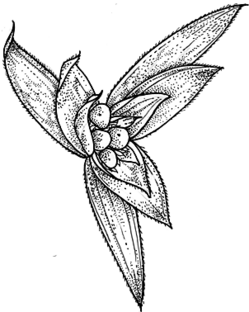
Description: Tufted dioecious herbs, perennial, rhizomatous; aerial parts usually covered with silvery scales, sometimes woolly.
Leaves 3-ranked, linear to lanceolate, keeled; sheath closed at base.
Inflorescence a terminal panicle; branches subtended by leafy or membranous spathes; bracts membranous. Flowers unisexual, actinomorphic. Tepals 6, free or basally fused. Stamens 6, shorter than tepals; anthers dehiscing by longitudinal slits, introrse; staminodes sometimes present in female flowers. Ovary superior, 1-locular with parietal placentas or 3-locular with axile placentas; stigmas 3; reduced ovary sometimes present in male flowers.
Fruit a berry surrounded by persistent tepals; seeds few–numerous, black.
Distribution and occurrence: World: c. 31 species, in and around the Pacific, with 1 species in Reunion and Mauritius and 1 species in the Falkland Is. Australia: 3 species (endemic), N.S.W., Vic., Tas.
Text by G. Harden; Kerry Gibbons, 26 Apr. 2023
Taxon concept: Harden Fl of NSW. Distribution and occurrence: Kew Plants of the World Online; Australian Plant Census [both accessed 24 Apr. 2023].
| | Key to the species | |
| 1 | Male panicles compact, mostly hidden by leaves; anthers more than 1 mm long; berry orange-yellow, 3-locular, 3-lobed; old leaf bases tomentose with short hairs | Astelia psychrocharis |
| Male panicles open, exserted; anthers less than 1 mm long; berry red, 1-locular, not lobed; old leaf bases silky with hair-like scales | Astelia alpina |
|


